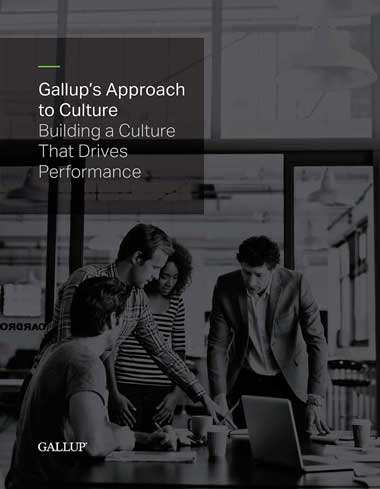Story Highlights
- Most employees want some level of remote work
- When allowing remote work, avoid prefabricated hybrid strategies
- Use seven questions to create flexible work arrangements at your company
For leaders figuring out the post-pandemic workplace, it may appear that there are three options: back to the office, fully remote or hybrid.
But in reality, "hybrid" is not a clear-cut category. Consider Gallup's recent survey of what U.S. employees say they want going forward:

Custom graphic. Gallup Panel data show that half of full-time U.S. employees want to work from home at least some of the time. Three in 10 want to work from home never or almost never, and two in 10 want to work from home all the time.
About half of workers prefer either exclusively on-site or exclusively remote work. The rest want something in between.
But for employees who prefer hybrid, there's no clear consensus on what "hybrid" means. For some, it means going to work most of the time -- for others, hardly ever.
The takeaway is that this is not the time to copy and paste generic "best practices" for hybrid work arrangements or a mainstream hybrid model. The biggest mistake leaders can make when crafting a hybrid work strategy is to select a standard approach.
Even the most progressive and innovative companies haven't totally figured out what works. And it's very likely that success will be largely defined by the unique industry, demographics, talent pool, culture and customer expectations of your one-of-a-kind organization.
The best thing leaders can do right now is to ask the right questions -- and answer them with their organization's needs in mind.
Here are seven questions to help leaders get started:
1. Why is hybrid right for our organization?
Consider the following two approaches to hybrid work that are vastly different, but both successful.
One organization that Gallup has worked with has a history and culture of rigid standards and documentation. Its hybrid approach needed to be absolutely black and white -- no gray area. So its leaders created a 10-page document spelling out in detail their rules and processes for hybrid work. It made sense to their employees because it matched the way they do things.
In contrast, another organization defined its remote work policy as two words: Work Appropriately. This was not a complete shock to its employees because it matched their experiences. That company's dress code? Dress Appropriately. Flexible policies like these empower managers to have ongoing conversations about each employee's role, responsibilities, team, personality and life.
Both of these approaches to hybrid work are effective because they are tailored to the organization in a way that is meaningful to its workers.
The biggest mistake leaders can make when crafting a hybrid work strategy is to select a standard approach.
2. How will the voice of our employees guide our approach?
Another mistake that some leaders are making is blindly following their gut instinct on hybrid work. This is problematic because leaders risk disengaging employees if they implement a plan that their people do not want. While leaders can't expect to satisfy everyone, they will appear out of touch with their people's needs if they do not understand and address common concerns and expectations.
Leaders need to have clear listening posts, such as pulse surveys, to get employees' perspectives on returning to the office. The right feedback channels will tell leaders what employees want, what they need and their greatest fears. Ultimately, surveys themselves don't solve problems -- they prompt the right kinds of conversations.
3. Will we phase in gradually or all together?
Although it may feel satisfying to simply select a date on the calendar and say, "Everybody returns to work on this day," leaders have many factors to consider. For example, differences in geography and job responsibilities can influence how, when and why employees come back. Moreover, many organizations are returning to a significantly altered economy and marketplace. This will likely cause many bumps, pauses and false starts along the way.
Ultimately, surveys themselves don't solve problems -- they prompt the right kinds of conversations.
The best leaders are embracing an experimental, adaptive approach. Workplaces may not know for 12 to 24 months what "returning to work" looks like or means -- and leaders should commit to learn and evolve to meet workers' needs.
That is, leaders should communicate to employees that they are in this together -- and that present changes may not be permanent. Leaders who relay this heartfelt, honest message prove that they are looking out for employees' best interests and wellbeing.
4. What determines flexible time in our organization?
One of the biggest changes in the post-pandemic workplace is the need for employers to justify the benefits of in-person work. We call this your "workplace value proposition." Instead of forcing employees to work in the office, employers should ensure their workplace offers a compelling draw for people -- a welcoming place for group identity creation, relationship building, project collaboration and ideation.
In addition, leaders should have a clear answer for why flexible time is valuable to the organization. Time out of the office can boost productivity by eliminating commutes and allowing for focused individual work without distractions. It can also benefit employee wellbeing by allowing employees the ability to save money, exercise more often, pursue a personal interest or care for family members.
5. How will our managers support leaders in making the shift?
At the height of the pandemic, remote work was not "business as usual" remote work. Managers had to discover how to manage remotely, even if they had no previous experience. Now, new questions about remote work are emerging: How do we create a consistent employee experience in both virtual and in-person spaces? How do we make sure that remote workers feel included in their teams? How can we make sure performance and promotions are fair, regardless of in-office attendance?
As leaders seek to answer these questions, they should focus on training and developing managers. Managers will be largely responsible for navigating and implementing decisions about remote work -- and their approach will influence team engagement and performance. Gallup research shows that remote workers are highly productive when they are managed well and have tasks that are a good fit for remote work.
Well-equipped managers will have the confidence and skills they need to set clear expectations and have engaging conversations, even when the "new normal" is TBD and there are no clear-cut rules.
6. Where will we see costs increase, decrease or shift?
Much has already been written about the potential cost savings of remote work. For instance, organizations with smaller offices -- or no offices -- certainly reduce overhead. But employers should perhaps consider shifting, rather than only decreasing, costs.
Here's an example: the run-of-the-mill office coffee pot. Leaders might consider investing in higher-quality coffee on a few select days to encourage intentional social interactions and create a better in-office experience. Many organizations have rituals centered on these "water cooler" moments. Leaders have an opportunity to rethink and reinvest expenses to better stoke collaboration and adapt to new needs.
In addition, leaders should consider how they can provide support and attention for workers with in-home offices. While leaders may welcome the cost savings of home offices, they should remember that those home offices are part of the total employee experience -- and allocate resources accordingly.
7. How will we evaluate what works (and what doesn't)?
To succeed, your approach to hybrid work has to benefit your business. But, like many aspects of corporate culture, defining success may be challenging.
Employee satisfaction with the policy may not be the best measure -- and productivity can be difficult to gauge for some roles. However, employee engagement (combined with hard costs) can be an ideal measure, as it is highly correlated with a variety of business outcomes, including profitability, retention and performance.
Here's the bottom line: If you don't create a framework for defining success, you won't know if your hybrid strategy is working six months from now. The right data will reveal not only what's working and what isn't, but also opportunities to tweak and optimize your approach.
Leaders: You have a window of opportunity -- a chance to explore, experiment and learn. Everyone understands that adjustments and evolution will be necessary. Leaders also need feedback mechanisms, and they should be open to changing their minds based on evidence about what's working.
The best leaders will take full advantage of this once-in-a-generation opportunity and seize this chance to reenergize and transform their organizational culture so that employees are not only happier at work, but also more engaged and productive.
Customize your hybrid work strategy to fit your company:
- Partner with Gallup for advanced analytics and advice.
- Learn more about the employee experience and improve the most important moments employees have at your organization.






